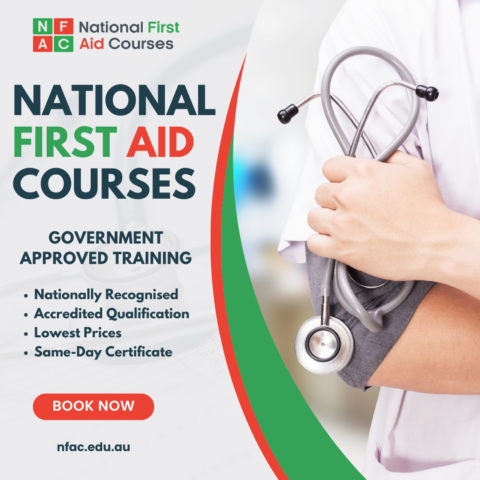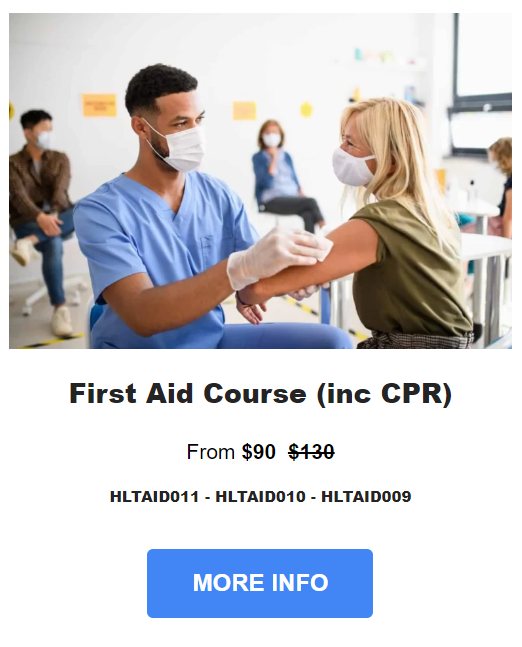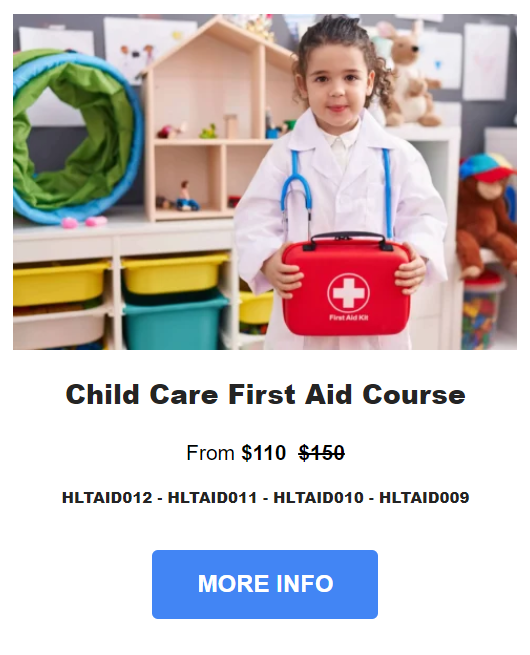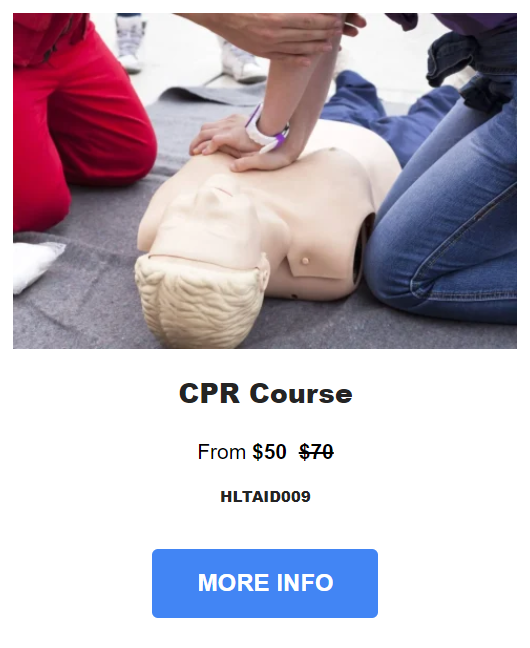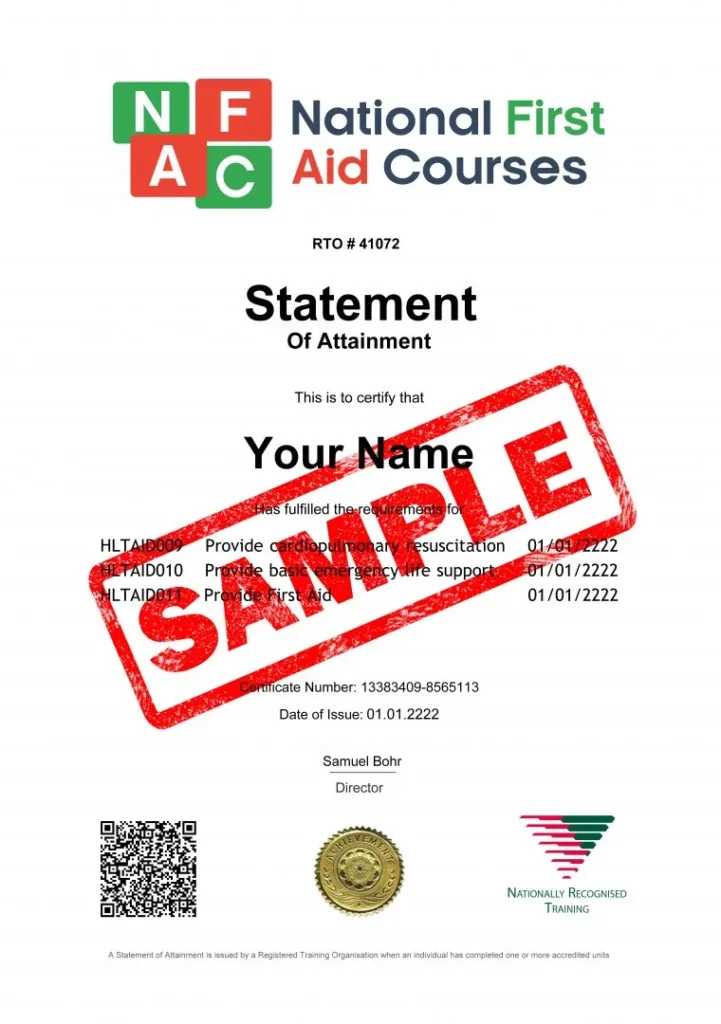
Table of Contents
Key Takeaways
- ✓ Specialised First Aid for Children: The HLTAID012 course focuses on managing emergencies involving infants, children, and adults in childcare and education settings.
- ✓ Meet Regulatory Requirements: This course fulfills legal obligations for childcare workers, including those in early learning centers and schools, ensuring compliance with Australian regulations.
- ✓ Gain Practical and Theoretical Skills: Learn critical skills like CPR, anaphylaxis management, and responding to asthma attacks through hands-on and theory-based training.
- ✓ Enhance Your Career Prospects: Holding a HLTAID012 certificate makes you a preferred candidate for childcare and education roles, showcasing your dedication to safety and care.
Introduction
What would you do if a child in your care suddenly had a severe allergic reaction? Or if a toddler fell and started bleeding from a deep cut?
Would you know how to respond?
In the world of childcare and education, being prepared for emergencies is not just important — it’s absolutely essential.
In Australia, childcare providers must adhere to strict legal requirements outlined in the National Quality Framework (NQF), which emphasises the importance of having qualified staff who can manage emergencies effectively.
Compliance with these regulations not only protects the children in your care but also safeguards your professional standing and the reputation of your service.
However, this isn’t just about meeting a requirement; it’s about making a real commitment to the safety and well-being of the children you care for every day.
The HLTAID012 Child Care First Aid course is your key to gaining the skills, confidence and certification needed to handle a wide variety of critical situations in education and childcare environments.
In this comprehensive guide, we’ll walk you through everything you need to know about obtaining your HLTAID012 certification. From understanding the course content to mastering the practical skills you’ll acquire, we’ve got all the details covered.
By the end, you’ll be ready to take the next step in your professional journey, ensuring that you’re not only compliant with regulations but also a proactive guardian in times of crisis.
Understanding the HLTAID012 Course
The HLTAID012 Child Care First Aid training is specifically designed for those working in childcare and education settings, equipping you with the essential skills to respond effectively in emergencies involving children.
Becoming certified in childcare first aid is not just a box to tick; it’s a comprehensive training program that prepares you for real-life situations where quick thinking and action can make all the difference.
What’s Included in the Course?
This course encompasses several essential units, ensuring that participants are well-equipped to handle emergencies in childcare settings.
By completing this course, you also earn certifications in the following areas:
- HLTAID012 Provide First Aid in an Education and Care Setting: Focuses on first aid principles tailored specifically for childcare environments.
- HLTAID011 Provide First Aid: Offers a broader understanding of first aid applicable to various situations beyond childcare.
- HLTAID010 Provide Basic Emergency Life Support: Teaches you how to provide essential life support in emergencies, ensuring you can respond effectively when needed.
- HLTAID009 Provide Cardiopulmonary Resuscitation (CPR): Covers the vital skills required to perform CPR on infants, children, and adults.
Completing the HLTAID012 course means you are certified in all these critical areas, making you a competent and confident caregiver prepared to manage emergencies effectively.
Key Differences from Previous Courses
One of the significant updates with HLTAID012 is its alignment with current best practices and regulatory requirements. It replaces the older HLTAID004 course, ensuring that you are trained in the most relevant and effective techniques for today’s childcare settings.
This course is also approved by the Australian Children’s Education and Care Quality Authority (ACECQA), meaning it meets the highest standards for childcare training.
Why This Course Matters
Completing the HLTAID012 course is not just about gaining a certification; it’s about building your confidence and competence in handling emergencies where children are involved.
You’ll learn how to manage asthma and anaphylaxis situations, respond to choking incidents, and provide first aid for cuts, bruises, and other common injuries in children.
These are skills that you will carry with you throughout your career, ensuring that you are always ready to act when it matters most.
By understanding the course content and its importance, you’re taking the first step toward becoming a more effective and prepared childcare professional.
It’s also important to note that while the course is designed for childcare professionals, the skills gained can also be extremely beneficial for parents and other caregivers who want to be prepared for emergencies involving children.
Course Content and Certification
This comprehensive course covers a wide range of topics that are crucial for anyone working in childcare or education.
From assessing emergency situations to providing life-saving care, this training will equip you with the knowledge and skills to handle even the most challenging scenarios.
What You'll Learn
During the course, you’ll dive deep into topics such as:
- Recognising and responding to emergencies: Learn how to quickly assess a situation and determine the best course of action.
- Performing CPR on infants, children, and adults: Master the techniques needed to provide effective cardiopulmonary resuscitation.
- Providing first aid for various injuries and illnesses: Gain the skills to treat cuts, bruises, fractures, asthma attacks, and more.
- Managing asthma and anaphylaxis emergencies: Learn how to recognise and respond to severe allergic reactions and breathing difficulties.
Provide First Aid in an Education and Care Setting Course Elements and Performance Criteria:
| Elements | Performance Criteria |
|---|---|
| 1. Respond to an emergency situation. |
|
| 2. Apply appropriate first aid procedures. |
|
| 3. Communicate details of the incident. |
|
| 4. Review the incident. |
|
Practical Skills Assessment
The HLTAID012 childcare first aid course involves more than merely memorising facts; it’s about developing practical skills that you can apply in real-life situations.
That’s why this training includes a hands-on skills assessment, where you’ll have the opportunity to demonstrate your abilities in a simulated environment.
This ensures that you are truly prepared to handle emergencies with confidence and competence.
Certification and Compliance
Upon successful completion of the course, you’ll receive a nationally recognised certification that meets the requirements for working in the childcare and education sector.
This certification demonstrates your commitment to safety and your dedication to providing the best possible care for the children in your charge.
Remember, having this certification not only enhances your professional skills, it also helps ensure that your childcare service remains compliant with the National Quality Framework (NQF) and other relevant regulations. It’s a win-win for you, your colleagues, and the families you serve.
Who Should Take the HLTAID012 Course
The Child Care First Aid certification is essential for a wide range of professionals who work with children.
Here’s a look at who should consider enrolling in this course:
- Child Care Workers
- Teachers
- Nannies
- Crèche and Daycare Staff
- Early Childhood Educators
- Youth Workers
- Family Support Workers
- Sports Coaches
- School Support Staff
- Pediatric Healthcare Providers
- Child Psychologists
- Camp Leaders
- Playgroup Coordinators
- Special Needs Educators
- Child Welfare Officers
- Babysitters
- Plus more
Choosing the Right Child Care First Aid Course Provider
Selecting the right Child Care First Aid course provider is crucial to ensure you receive quality training that meets your needs and complies with regulatory requirements.
Here are some key factors to consider when making your choice:
1. ACECQA Approved
First and foremost, ensure that the course is approved by the Australian Children’s Education and Care Quality Authority (ACECQA).
This approval guarantees that the training meets the national standards required for childcare professionals and is recognised across Australia.
2. Course Format
Consider the format that best suits your learning style and schedule. Many providers offer different options, including:
- In-Person Training: Ideal for hands-on learners who benefit from direct interaction with instructors and peers. This is the most effective first aid training format available.
- Online Courses: Flexible and convenient, allowing you to study at your own pace however, you’ll still need to complete a practical assessment in person.
- Blended Learning: A combination of online theory and in-person practical sessions.
3. Instructor Qualifications
The quality of your training largely depends on the experience of the instructors.
Only enrol in courses led by government approved trainers and course providers.
4. Essential Skills Covered
Ensure the course covers essential topics relevant to childcare, such as:
- Managing asthma and anaphylaxis.
- CPR techniques for infants, children, and adults.
- Basic emergency life support.
A comprehensive curriculum prepares you for a variety of situations you may encounter.
5. Reviews and Recommendations
Look for positive reviews or testimonials from past participants.
Hearing about others’ experiences can provide insight into the quality of the training and the effectiveness of the instructors.
6. Choose a Registered Training Organization (RTO)
Make sure you select a provider that is a Registered Training Organisation (RTO).
This ensures that the course complies with national vocational education and training (VET) standards, guaranteeing that your certification is recognised throughout Australia.
Maintaining Certification
Obtaining your HLTAID012 Child Care First Aid certification is an important milestone in your professional development, but it doesn’t end there.
To ensure that you remain competent and compliant with current practices, it’s essential to understand the requirements for maintaining your certification.
Renewal Period
In Australia, the HLTAID012 certification is valid for three years.
After this period, you will need to renew your certification to ensure your skills and knowledge are up-to-date.
Additionally, the CPR component of the course typically requires renewal every 12 months.
Staying current with your training is crucial, especially in a field where children’s safety is at stake.
Refresher Courses
To renew your certification, you can take a refresher course that focuses on the essential skills and knowledge required for first aid in childcare settings.
Many training providers offer these shorter courses, which are designed to update your skills without requiring you to retake the entire course.
This can be a more efficient and cost-effective way to maintain your certification.
Staying Informed
In addition to formal training, it’s important to stay informed about any changes in first aid practices or regulations that may affect your role.
Regularly reviewing updates from reputable sources, such as the Australian Resuscitation Council or ACECQA, can help you stay current with best practices and emerging trends in childcare safety.
Hands-on Practice
Consider practicing your skills regularly, even outside of formal training sessions.
This can include reviewing CPR techniques, practicing bandaging, or simulating emergency scenarios with colleagues.
The more comfortable you are with these skills, the more confident you will be in a real emergency.
Documentation
Keep your certification documentation organised and accessible.
This not only helps you remember when it’s time to renew but also ensures you can provide proof of your qualifications to employers or regulatory bodies when needed.
Real-World Applications
The skills and knowledge you gain from the Child Care First Aid course are not just theoretical; they have practical applications that can make a significant difference in emergency situations.
By applying the skills learned in this course to real-world situations, you’ll be better prepared to handle emergencies with confidence and competence.
This training not only enhances your professional capabilities, it also ensures the safety and well-being of the children you care for.
Here are some real-world scenarios where your training will make a significant impact:
Managing Allergic Reactions
Imagine a child in your care suddenly experiencing a severe allergic reaction.
With the training from the HLTAID012 course, you’ll know how to recognise the signs of anaphylaxis and respond swiftly.
You’ll be equipped to administer an EpiPen and call for emergency help, potentially saving a life.
Responding to Injuries
Accidents happen, especially with young children.
Whether it’s a scraped knee from a fall or a deeper cut from a sharp object, your first aid training will enable you to assess the injury, provide appropriate care, and decide if further medical attention is necessary.
Knowing how to clean and dress wounds can prevent infections and promote faster healing.
Handling Choking Incidents
Choking is a serious risk for children, particularly during mealtime or while playing.
Your training will prepare you to recognise the signs of choking and perform the necessary first aid techniques (such as back blows and abdominal thrusts) to clear the airway and ensure the child can breathe again.
Dealing with Asthma Attacks
For children with asthma, knowing how to respond during an asthma attack is crucial.
You’ll learn how to help a child use their inhaler correctly and recognise when to seek further medical assistance.
Your ability to manage these situations can provide comfort to both the child and their parents.
Providing CPR
In the unfortunate event of a cardiac arrest, your CPR training will enable you to act quickly and effectively.
Whether it’s a child or an adult, knowing how to perform CPR can mean the difference between life and death.
Your skills will empower you to take action until professional help arrives.
Supporting Emotional Well-Being
First aid isn’t just about physical injuries; it also involves supporting the emotional well-being of children during emergencies.
Your training will help you understand how to comfort and reassure children who may be frightened or anxious after an incident, helping them feel safe and secure.
Creating a Safer Environment
Beyond responding to emergencies, your first aid training will also encourage you to create a safer environment for the children in your care.
You’ll learn to identify potential hazards, implement safety measures, and educate children about basic safety practices, fostering a culture of safety in your childcare setting.
Preparing for Your Child Care First Aid Course
Getting ready for your HLTAID012 Child Care First Aid course can help you make the most of your training experience.
Here are some practical tips to ensure you’re fully prepared for the course:
Review Course Materials
Before the course begins, take some time to review any materials provided by your training provider, such as learning guides.
Familiarising yourself with the content can give you a head start and help you feel more comfortable during the training sessions.
Dress Comfortably
As the course includes practical assessments, it’s important to wear comfortable clothing that allows for movement.
You will be practicing CPR techniques and other hands-on skills, so choose attire that won’t restrict your movements.
Bring Necessary Supplies
Check with your training provider to see if you need to bring any specific items. Commonly required supplies may include:
- A notepad and pen for taking notes.
- Any personal medications you might need.
- A water bottle to stay hydrated.
- Snacks to keep your energy levels up during the course.
Prepare Mentally
Approach the course with a positive mindset and an eagerness to learn.
Remember, this training is not just about passing a test; it’s about gaining valuable skills that can make a real difference in emergency situations.
Being mentally prepared will help you absorb the information more effectively.
Engage with Instructors and Peers
During the course, don’t hesitate to ask questions or engage with your instructors and fellow participants.
Sharing experiences and discussing scenarios can enhance your learning and provide different perspectives on handling emergencies.
Stay Open to Feedback
Be open to receiving feedback during your practical assessments.
Constructive criticism is a valuable part of the learning process and can help you refine your skills.
Remember, everyone is there to learn, and your instructors are there to support you.
Frequently Asked Questions (FAQs)
As you consider enrolling in this course, you may have some questions.
Here are some common FAQ and answers to help clarify what to expect from the training:
How long does the HLTAID012 course take to complete?
The duration of the HLTAID012 course can vary depending on the training provider and the format you choose. Typically, the course includes an online theory component followed by a practical assessment session.
Overall, you can expect to complete the course in one day (approx. 6-7 hours)
Is the HLTAID012 course accredited?
Yes, the HLTAID012 course is a nationally accredited training program recognised across Australia.
It meets the regulatory requirements set forth by the Australian Children’s Education and Care Quality Authority (ACECQA), making it a valid certification for childcare professionals.
Can I complete the course online?
To achieve national accreditation and recognition, this course requires mandatory face-to-face training.
While some providers may offer online theory components, practical assessment must be conducted in person.
This hands-on approach is essential for mastering the skills required for this qualification.
Please verify the specific delivery format with your chosen training provider.
What if I have special needs or require certain provisions?
If you require any specific provisions, it’s important to communicate this with your training provider before the course begins.
Most providers are willing to make reasonable adjustments to ensure that all participants can fully engage with the training.
What happens if I don’t pass the practical assessment?
If you don’t pass the practical assessment on your first attempt, don’t worry!
Most training providers will allow you to retake the assessment. They are there to support your learning and ensure you feel confident in your skills before receiving certification.
Will I receive a certificate upon completion?
Yes, upon successfully completing the course and passing the practical assessment, you will receive a nationally recognised certificate.
This certification demonstrates your commitment to safety and your preparedness to handle emergencies in childcare settings.
Can parents take this course?
Absolutely! Parents and guardians are encouraged to take the HLTAID012 course.
Knowing how to respond in emergencies can make a significant difference in your child’s safety and well-being, giving you the confidence to act when it matters most.
Common Myths About HLTAID012 Child Care First Aid Certification
As you consider enrolling in the Child Care First Aid course, it’s important to separate fact from fiction.
Here are some common myths about the course and the realities that dispel them:
Myth 1. First Aid Certification Is Only for Teachers and Childcare Professionals
Reality: While the HLTAID012 certification is essential for childcare workers, educators, and healthcare professionals, it is also extremely beneficial for parents, nannies, babysitters, and anyone who interacts with children.
Having first aid training equips you with critical skills that can save lives, regardless of your professional background.
Myth 2: The Course Is Too Complicated
Reality: Many people believe that first aid training is overly complex and difficult to grasp. However, the HLTAID012 course is specifically designed to be accessible and engaging.
The content is presented in a clear, practical manner, allowing participants to learn essential skills without feeling overwhelmed.
Myth 3: You Only Need to Take the Course Once
Reality: The HLTAID012 certification is valid for three years, after which you must renew your training to stay compliant with regulations and current best practices.
Additionally, the CPR component typically requires annual renewal.
Myth 4: Online Courses Are Sufficient
Reality: Although some components of the HLTAID012 course can be completed online, practical skills assessments are crucial for effective learning and a requirement to gain a nationally recognised childcare first aid certificate.
Hands-on training allows you to practice techniques in real-life scenarios, ensuring you feel confident and competent when responding to emergencies.
Myth 5: All First Aid Courses Are the Same
Reality: The HLTAID012 course is specifically tailored for those working in childcare and education settings, ensuring that the content is relevant and applicable to the unique needs of these environments.
It meets the standards set by the Australian Children’s Education and Care Quality Authority (ACECQA).
Conclusion
Obtaining your HLTAID012 Child Care First Aid certification is more than just a professional requirement; it’s a vital step towards ensuring the safety and well-being of the children in your care.
The skills and knowledge you gain from this course enable you to respond effectively in emergencies, providing peace of mind for both you and the families you serve.
By completing this training, you demonstrate your commitment to high-quality childcare and your readiness to handle any situation that may arise.
Whether you’re an educator, a nanny, a sports coach, or a parent — the ability to act decisively in emergencies can save lives and make a significant difference.
Take the Next Step: Enrol in a Childcare First Aid Course Today!
Ready to gain the essential skills and knowledge to respond confidently in emergencies involving children?
Look no further than National First Aid Courses — a leading provider of accredited Child Care First Aid training in Australia.
As a Registered Training Organisation (RTO 41072), we guarantee the highest standard of training tailored specifically for childcare professionals and caregivers.
Our HLTAID012 Provide First Aid in an Education and Care Setting course is officially accredited and nationally recognised, ensuring you receive the most relevant and up-to-date training available.
Our comprehensive course covers critical skills, including:
HLTAID012: First aid principles tailored for childcare environments.
HLTAID011: Broader first aid knowledge applicable to various situations.
HLTAID010: Basic emergency life support techniques.
HLTAID009: CPR skills for infants, children, and adults
With face-to-face training by government approved instructors, 8 convenient locations across New South Wales, and affordable prices — we make it easy for you to become a certified first aider.
Enrol in one of our upcoming courses and secure your spot today!
Author Bio:

Jacqueline Lisa
Manager and Accredited First Aid Trainer at National First Aid Courses (NFAC)
With over a decade of experience in the childcare and aged care industries, Jacqueline has dedicated her career to applying her First Aid knowledge in real-world settings. As an accredited First Aid trainer and manager at National Courses PTY LTD, Jacqueline is committed to delivering nationally recognised First Aid and CPR courses across Australia. She combines her hands-on experience with a passion for teaching, empowering others with the critical skills needed to make a difference in emergency situations.
Connect on Social Media
Contact Us For Assistance
- 1300 623 613
- admin@nfac.edu.au
- Monday to Friday: 8:30 am – 4:30 pm
Share This Article:
Related Articles:
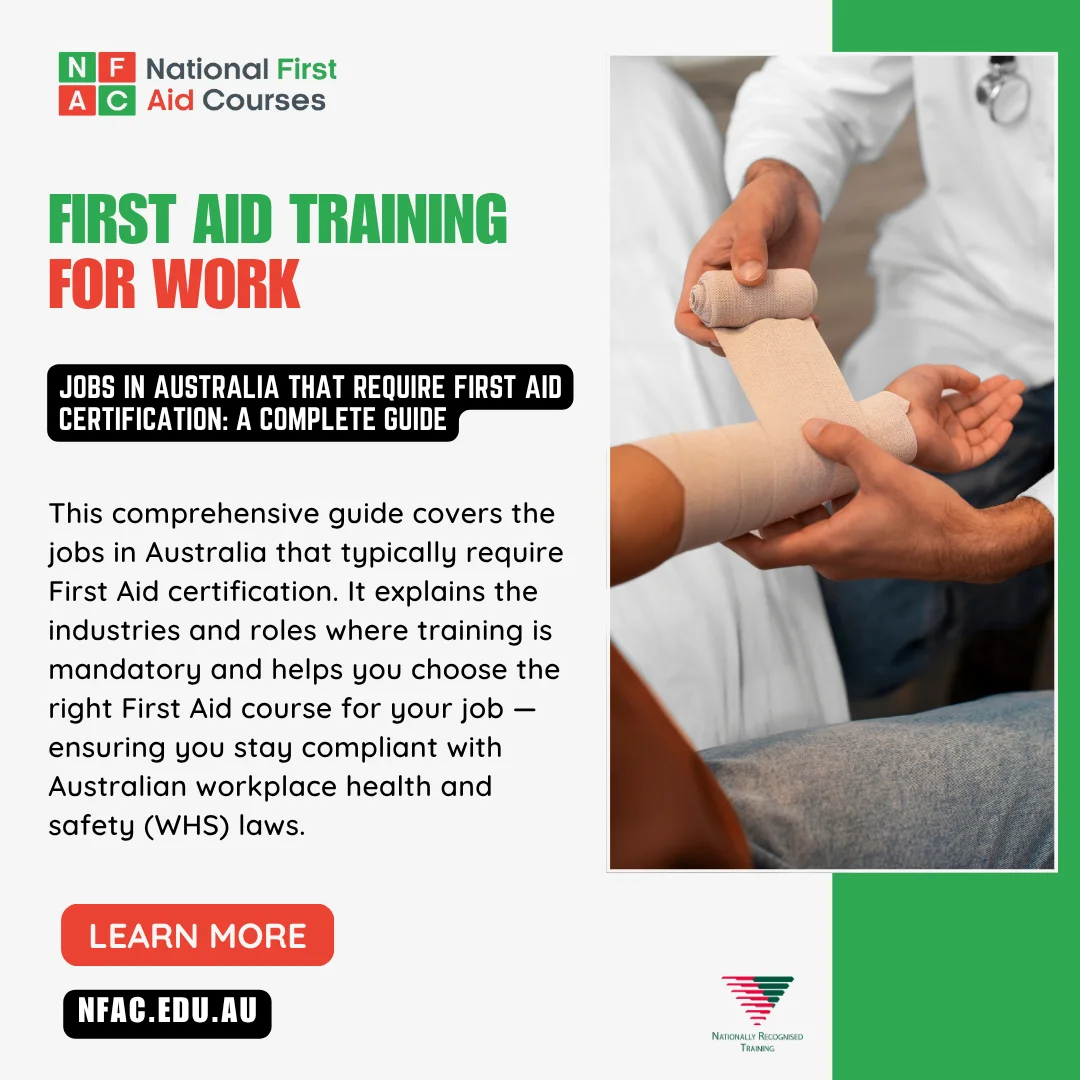
Jobs in Australia That Require First Aid Certification: A Complete Guide
In this guide, we’ll break down the jobs and industries in Australia that require First Aid certification, from construction and healthcare to childcare, mining, and more. You’ll learn which roles have mandatory training requirements, how often certificates need to be refreshed, and which course — Provide First Aid, CPR, or Childcare First Aid — applies to your workplace. Plus, we’ll explain how staying certified keeps you compliant with WHS laws and gives you the confidence to act when it matters most.
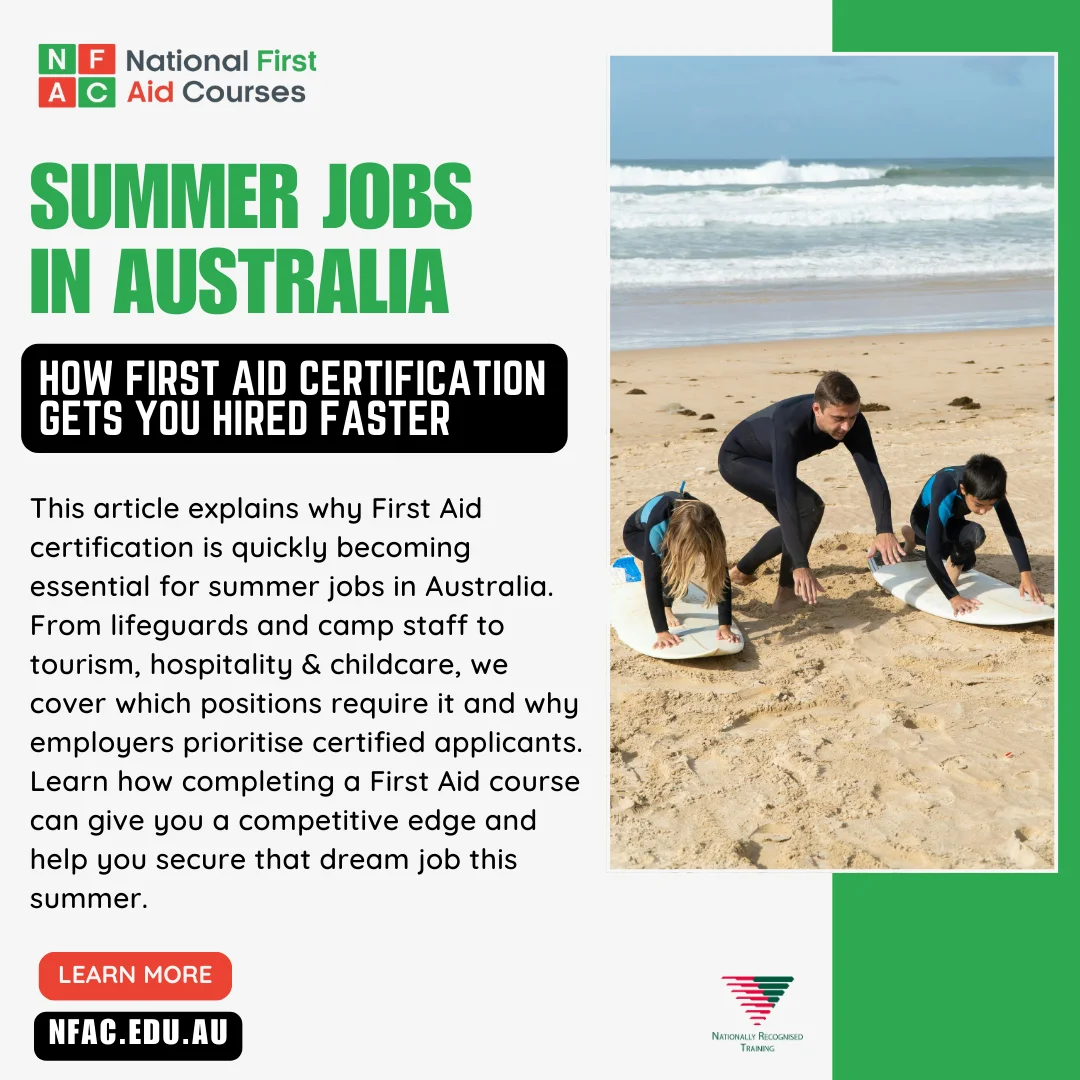
Popular Summer Jobs in Australia: How First Aid Training Can Get You Hired
In this article, we look at why First Aid and CPR training is a must-have skill for anyone volunteering at summer events across Australia. From community festivals to sports carnivals and charity fundraisers, we cover the safety expectations, heat-related risks, and the accredited training that ensures you’re ready to act fast when emergencies strike in the summer heat.

Find a First Aid Course in NSW: Sydney, Newcastle, Wollongong, Central Coast & More
In this guide, we’ll show you exactly how to find the best First Aid course in New South Wales — whether you’re in Sydney, Newcastle, Erina, or Wollongong. From understanding accredited training requirements to comparing face-to-face vs online options, you’ll learn what matters most before booking. Plus, we’ll share tips for choosing a provider that guarantees practical, hands-on skills you can trust in an emergency.
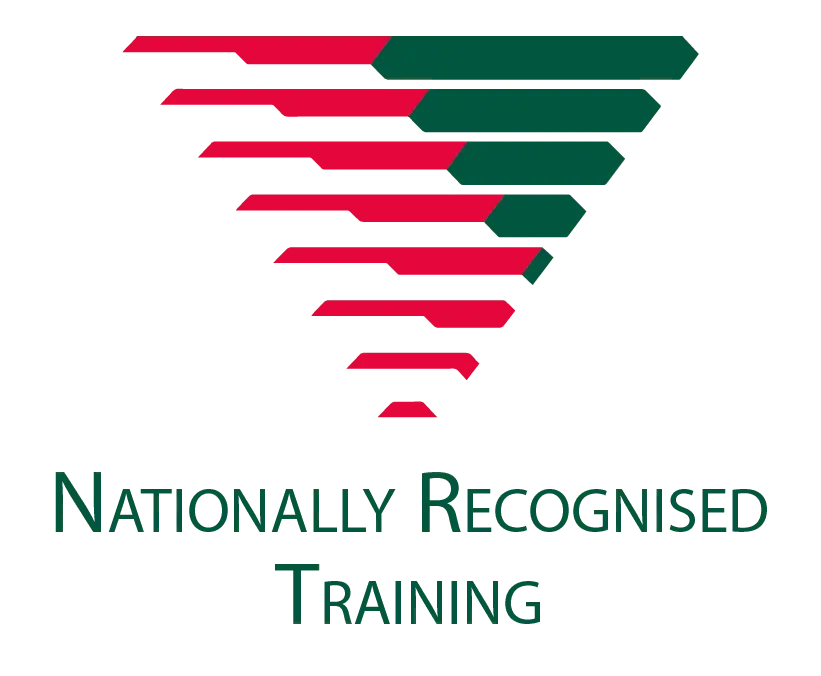
National First Aid Courses
ABN: 65 161 255 278
RTO 41072
View our credentials here
Privacy Policy and Terms of Use
- 1300 623 613
- admin@nfac.edu.au
- Monday to Friday: 8:30 am – 4:30 pm
- We also run weekly after hours courses
© 2025 All rights reserved.
